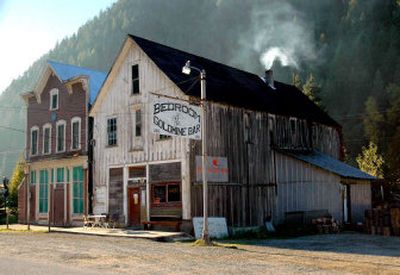Gazing into Murray’s past

You can still find gold nuggets around this town and lots of interesting stories. Some of the stories are old, some are new and they may or may not be true. The old, weathered look of the buildings will take you back to a time when mining was king and this part of Idaho was wild. Murray is an interesting place to explore.
There was a time when Murray’s population was greater than Boise’s as Idaho Territory emerged into statehood. It all started when A.J. Prichard followed the Mullan Trail military road east past where the Old Mission stands and into the Coeur d’Alene Mountains. Prichard found placer gold in 1882. Amazingly, by the winter of 1883 there were 2,000 miners, prospectors and camp followers in this remote area. By 1885, there were 10,000.
Wyatt Earp, the U.S. lawman known for being fast with his gun, showed his dark side in Murray by jumping another man’s claim. Earp had just left Tombstone, Ariz., after his famous shootout at the OK Corral. He forced W. Payne by gunpoint off Payne’s land but in court claimed that there had been a mere miscalculation of geography. The judge didn’t buy the story and fined Earp $65 for the trouble he caused.
In modern Murray, as you turn the corner into town, you’ll see an old building that is a local watering hole. An owner built a bedroom onto the back of the building and dug a mine under the floor, hence the name Bedroom Gold Mine Bar.
Like almost every mining town in the West, Murray had its share of prostitutes. In the town cemetery, about a half-mile up the Kings Pass Road, are many old tombstones. Some that are wooden, and two of the marked grave sites are of women who are associated with the oldest profession. Edith McCorkadale’s grave marker lists her birth and death dates of 1882-1905. During her short life she was known as “Terrible Edith.”
Another wooden marker bears the name Maggie Hall. Artificial flowers decorate her grave. She also died young at 35, on Jan. 17, 1888, of tuberculosis. But she had made a different kind of legacy in Murray, so much so that the town still remembers her with an annual festival called Molly B’Damm Days.
As the legend goes, Molly, whose given name was Maggie Hall Burdan, emigrated from Ireland along with her thick Irish accent that caused people to begin pronouncing her last name as “B’Damm.” Molly opened a saloon and soon was plying her trade.
Cort Conley in his book, “Idaho for the Curious,” says the rumor was that “Molly would allow the local gents to assist at her bath; the amount of their assistance was directly proportional to the quantity of gold dust they sprinkled in her tub.”
But Molly had another side that made her locally loved and famous by most of the people in town. Anyone who was sick or down on their luck would find Molly helping them out. Even her “customers” who became sick or needed a loan received help from her. She would hand out money or offer food and care for people in need.
In a show of kindness and respect when Molly herself became seriously ill, the proper ladies in town gave her 24-hour care until she died. The town closed for business the day of her funeral.
Murray is a semi-ghost town, meaning that there are still people – population about 50 – who live and work among the remaining old buildings. Rumor has it that one full-time miner is still recovering 10 to 16 ounces of gold per day at his claim.
Next to the Bedroom Gold Mine Bar is the Masonic Lodge, built in 1890. It would be hard to pass by this two-story, false-front, weathered wood frame building without taking a photograph. Farther up the street is a reconstructed replica of the old courthouse. The original was used as the Shoshone County Courthouse from 1884 to 1898 and as the gold dredge office from 1889 to 1926. A heavy snow load collapsed the original building.
There are other old buildings in Murray, but the must-see is the Sprag Pole Bar and Museum, which boasts a collection of mining equipment and historic “stuff” unlike any other.
In 1933 Walt Almquist bought what was an 1886 stagecoach stop building along the route to Thompson Falls, Mont. He renovated it and opened the Sprag Pole Inn. A friend gave him an old whiskey jug to display in the bar, and Almquist never stopped collecting until he died in 2000. His brother Harry continues the family tradition. Don’t expect a small collection of historic items here. There are five connected buildings and 10,000 square feet displaying mostly local history. There is a blacksmith shop, old-fashioned school room, barbershop and doctor’s office. It’s no surprise that historic photos accompany exhibits of actual panning, hydraulic, underground and dredge mining equipment.
The dredge that turned stream bottoms into rows of gravel that still can be seen today netted the owners in excess of $1 million. It is claimed that some of that money constructed the Empire State Building in New York City. Whiskey bottles and old glass medicine bottles line several shelves and household “kitchen tools” are part of the collection. The list of items is huge and you will enjoy taking in the history that can be found here at the Sprag Pole Inn.
Murray still might surprise modern-day miners who use metal detectors to find where to search. With its ghost-town look and feel, historic Murray has a way of surrounding you. It’s a good destination to put on your to-do list.